Announcement: Steemit 101 e-book released for free (Part 2)
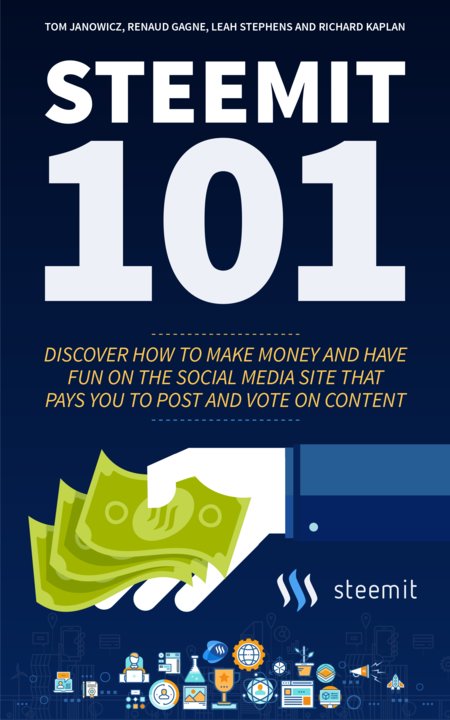
This is Part 2 of the Steemit e-book; you can find Part 1 here: https://steemit.com/steemit/@donkeypong/announcement-steemit-101-e-book-released-for-free-part-1
If you prefer a PDF copy, you can find it here: http://docdro.id/ZKd07nA
Chapter 7: Make Money Voting, Commenting, and Having Fun
Another brilliant thing about Steemit is that you don’t need to be a great writer to make money on the site. A generous 25% of the value of each post is paid to the curators, those who vote and comment on that post. So you also get paid for voting and commenting on other peoples’ posts. On Steemit, users are the curators, making sure good content rises to the top, gets read, and gets rewarded.
Voting
Voters make great money on Steemit by voting early on posts that become popular, though you need to wait a few minutes before voting on a new post (we will discuss this part soon). The first few votes are very important in bringing a post to the community’s attention, so if you are among the first to discover a good post, you will get a higher paying reward than if you vote after it has become popular.
In the short term, you may make the most money by following top writers on Steemit, since they have track records of creating popular posts that are likely to have big payouts. When you upvote these, you get to share in the total payout, and your share will be highest if you vote early and/or have lots of STEEM Power (more on that in the Steemit Economics chapter). But when you vote on the most well-known writers, you also will be competing there with others (including bots) who are looking out for these names and will upvote them immediately.
Longer term, the better strategy is to upvote some sure-thing posts every day and get your share of those payouts, but also keep a look-out for any up-and-coming writers. There are plenty of Steemit users who are posting really good content, but some of them are new and they are just beginning to get noticed (and get larger payouts). Follow anyone you like and use some of your votes to encourage and support them, even if these votes do not make you much money. As they begin to get noticed and get more upvotes, make sure to jump in early to upvote their posts before many others do. If you spot the good ones, you will make much more money this way.
Below is a screenshot that shows the end of a blog post. Where it displays the number of votes, you will see an arrow to the right. Clicking on the arrow opens up a list of the users who have voted on that post already.
In the picture below, the arrow has been clicked so that you can see the list of people who have voted for this post. (+) means an upvote and (-) means a downvote. Those with most voting power for this post are listed at the top, and the list continues in descending order from most to least voting power. Hopefully, in the near future, the developers will make this larger, since the arrow is a bit too difficult to click on from a mobile device.
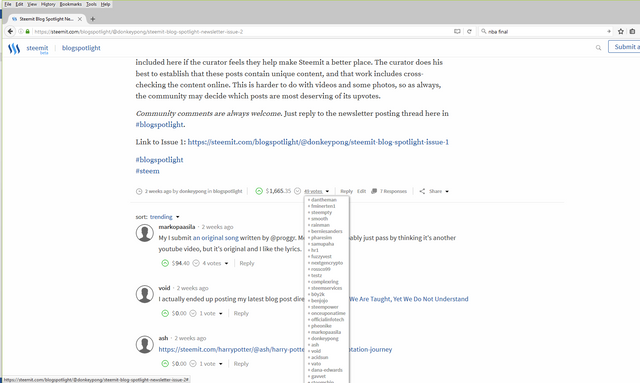
At the time of this writing, the value of the above post was $1,665.35. This value will decline somewhat, because additional STEEM tokens are being mined and introduced into the system, diluting the value a little bit each day. With daily payouts, we will not notice this dilution as much. Changes in STEEM’s market cap may affect this as well. For purposes of this example, though, we’ll call it a $1600 post.
Curators Make 25% of a Post’s Payout
Will the post’s author (Tom, @donkeypong) get paid over $1,600 for writing it? No, absolutely not, because that is the value of the entire post. On each post, at least 75% is paid to the author(s) and up to 25% is paid to the curators. The curators are the voters and commentators. The voters discovered it, found it to be worthwhile content, and upvoted it to a position where the content would be read by a lot of people. The commentators engaged in the conversation and created a rich discussion on Steemit. Everyone involved in making this a high-paying post will get paid a part of it.
Early Voters Get Rewarded. More STEEM Power means more Voting Strength.
Steemit considers voting to be a valuable function. Voters who find the post early and upvote it will profit the most, compared with people who voted on it later. HOWEVER, you should not vote on posts right after they are submitted; it is best to wait a few minutes or as long as 30 minutes before voting. This is because of the reverse curation voting system, which is discussed further below.
How can you make money voting? By finding good quality posts early, before most others have had a chance to vote on them. If you are one of the first people to upvote a post that later becomes popular, then you will make a lot more money than people who find it later. But you should not vote RIGHT AWAY on any post, as we will explain in the next section.
Voting strength also is determined by how much STEEM Power one has. You can accumulate more STEEM Power by buying it or earning it. When you reach the chapter on STEEM Power, we will explain this more thoroughly.
In the voter list above, some of the names between the middle and top of that group do not have large amounts of STEEM Power. Yet they exercised disproportionately high voting power on that post. How? Because they found it and voted it up before most others did.
Reverse Auction Curation System for the first 30 Minutes
When Steemit first launched and when this e-book was first published, this system did not exist yet. Once it was implemented, Richard @steemship and Adil Elias @the-alien wrote a nice article explaining how it works. We have adapted the article into this section. Adil @the-alien gets a big credit on this revision; he is one of Steemit’s best writers and we hope you will follow his blog also.
As you probably know, Steemit pays users to post and to curate. In the past, “curation” meant “voting”, and the most profitable strategy was to vote as EARLY as possible on any post that seemed likely to become popular. This is a good system, because it rewards people for discovering good posts and bringing them to the community’s attention.
However, under Steemit’s old rules, voting bots could jump to the front of the line, casting the most profitable early votes on a promising post. (A bot is a simple software program that runs automated tasks, like voting faster than you can on something that a popular Steemit writer has just posted.) While we are not passing judgment on bots, which do fulfill a certain purpose, the people using bots certainly have held an advantage so far.
We can compare this to buying a FastPass at Disneyworld or another amusement park; many such parks offer an advantage pass for those who buy a membership or pay extra. While average people have to wait in lines for popular rides and attractions, FastPass holders can jump to the front of the line because they paid extra for that privilege.
When Steemit first launched, users were highly incentivized to vote early on soon-to-be popular posts. The logic behind that was very simple. If you were the first user to upvote something that becomes popular later on, you would get a larger payout in comparison to the rest of the upvoters.
But now there is a new system in place, and while it’s still true that voters get paid a big chunk of the money from each post, there is another variable added to the equation. From now on, all curation rewards earned by voting in the first 30 minutes are to be shared with the author. If you vote right away after the post is submitted, then the author gets most of your reward, but if you wait longer you get more. Of course, others can jump in during that time, so if you wait longer to vote, the consequences can be both positive and negative. On the one hand, you make a higher percentage of the payout by waiting as long as possible within that 30 minute period. But then again, other people may vote ahead of you, reducing your payout.
This is a reverse auction system, inviting everyone to jump in any time with your vote during the first 30 minutes following a post’s submission. You will get a different share of the reward depending on when you vote. And you need to decide when is the most profitable time to vote, since others may jump into line ahead of you!
What is a Reverse Auction System?
Most people are familiar with traditional auctions. A seller lists a product for sale and buyers compete to purchase it. The buyers drive up the price on one another, so more competition yields a higher price for the seller. A regular auction benefits the seller more than the buyers.
In a reverse auction, the tables are turned. It is the buyer who announces a need, while the sellers compete for that buyer’s business. Procurement systems, both in government and in business, often use a reverse auction system. They announce a need and let suppliers or labor brokers compete for the lowest bid that still makes financial sense. The competition results in lower prices, as each seller is trying to beat the others’ prices to get a deal done.
Less money is wasted on artificial profits, and if those resources are put to more productive use, then this system has the power to help create a more efficient economy.
Fortunately, Steemit is its own economy and no resource needs to be wasted. It’s not exactly as if any money saved from voting goes to some greedy corporation. It still goes to author and curator rewards, which both remain quite generous. Implementing the reverse auction system for voting simply provides bots with a little more competition over a longer period of time (as long as 30 minutes instead of just seconds), and gives people a little more time to read posts before they vote. So determining the best price point is now purely depending on the free market economy. And that price point will be settled by when people (and bots) decide to vote.
Here is what Steemit’s Reverse Auction Voting system means for you:
• Voting early on posts that you think will be popular is still a good thing, but you should not vote too early.
• If you vote immediately after a post is submitted: The voter gets almost zero, the author gets nearly 100%.
• If you vote 15 minutes after a post has been submitted: The voter gets 50% of the curation reward, and the author gets the other 50%.
• If you vote 30 minutes (or later) after a post is submitted: The voter gets 100% of the curation reward.
The time curve is linear. The reward is progressively changing throughout that first 30 minutes. So the 15 minute mark is just an example; there is no special milestone occurring at 15 minutes. The only real milestone is at 30 minutes, when the voter hits the 100% curation payout. Until then, the author’s portion of the reward is declining and the voter’s portion of the reward is increasing, the longer you wait to upvote the post.
That means that you could jump in at any point with a vote, whether it’s at the 2 minute or 10 minute or 18 minute or 23 minute or 29:59 minute mark, or at any other point, and you would land on a point where your split with the author would be very predictable.
Why wouldn’t you wait until 30:00 to push the upvote button? Because others may vote much sooner. They are comfortable sharing a large piece of the pie with the author. And you might want to beat them to claim your earlier spot in line. It still pays to discover posts before others do. So you will need to watch and learn and ultimately decide for yourself when it is most profitable to vote.
Voting Strength
As far as the number of times you vote per day, voting 20-40 times is probably best. Your voting strength is maximized when you vote once every 36 minutes, though there is not a big difference if you vote on several things in a very short period. But the more you vote in quick succession, the more your voting strength declines. Voting strength regenerates over a five day period.
There may soon be a feature on Steemit that shows your voting strength. Until then, you can see yours on a backend companion site, which is steemd.com. Just enter your username in the address bar, such as https://steemd.com/@steemship. It’s exactly the same as the address for your blog page on Steemit, except that the “it” in Steemit.com is replaced with a “d” for the d-site.
In the screenshot below, you can see some of the back-end details for @steemship’s account. If you look at the left-side menu, about eight lines down, you will see Voting Power. At the time of this screenshot, Richard’s was over 97%, which means he needs to get out and vote some more! Not using your voting power is money down the drain.
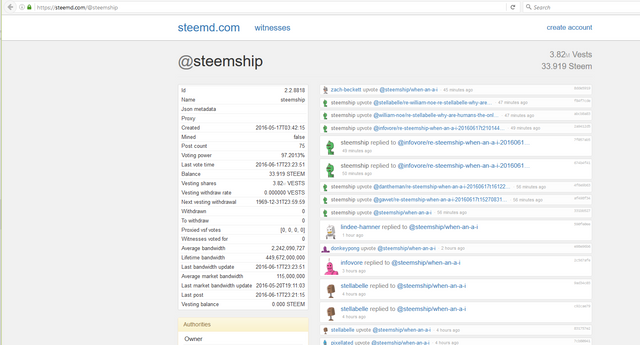
Lessons on Making Money from Voting
In summary, here are some good lessons about voting:
There is some big money to be made simply from upvoting good content. You need to find and recognize a good post before it becomes popular. And you need to strike fast, before others find it, but not too fast that you split most of your rewards with the author. Having more STEEM Power also gives you greater voting power (please see the separate chapter on how STEEM Power works).
How do you know the content is good? Mining for hidden gems is not easy, but one way to recognize good content is to spend some time reading the posts that became most popular. Learn to spot posts that are well-organized, longer than average, easy on the readers (perhaps including subheadings and images), full of original content, and saying something new or useful.
In addition, you can follow successful blog posters and any up-and-coming posters you find. Even if there are automated bots voting on these articles before you get the chance to do so, there will still be money for newbies.
It is also a good idea to stay on top of any changes in the reward system for curation (voting and commenting), because these may continue to change as the site moves forward. Changes are announced on the site, you can ask any questions in #steemhelp or on Steemit.chat and you should follow the blogs from the founders, who probably will announce any changes through one of these accounts: @dantheman, @ned, or @steemitblog. We will do our best to continue updating this book to reflect any important changes.
Making Great Comments
Next, we will look at comments, which are rewarded to stimulate discussion.
Let’s take a moment to consider what makes a popular comment. While it’s a great idea to post as many comments as you want on as many posts as you enjoy reading, quality is likely to be higher-paying for you than quantity. This article focuses on writing top-level comments which are likely to get a healthy share of upvotes.
Why are ‘upvotes’ important here? Because you’re not going to get paid just for spamming reply comments on every rich blog post. You’re going to get paid when your comments receive enough upvotes that they receive a healthy portion of the curation awards allotted to that post. Quality beats quantity.
Tom, a.k.a. @donkeypong, analyzed many past reply comments to see which ones were most popular (upvoted) and what elements these had in common. Here is his list of tips for making a popular comment. If you follow these tips, then not only will you add to the high quality of discussion on Steemit; you should make some money also!
Top 5 Tips
Tip 1. Spot popular posts and strike early. If a post is likely to get a lot of votes and a large payout, then the top comments should get upvoted and paid well also. The first comment or two have the best chance to claim this reward, though someone may come along later and write an even better reply. If you make a good reply post early and do it consistently, you won’t get rewarded every time, but on average you should score more hits than misses.
The following screenshot shows an example reply by @brandonp on one of @gardenlady’s posts that shows you the first good reply can pick up some votes. It also follows some of the other tips in this article.
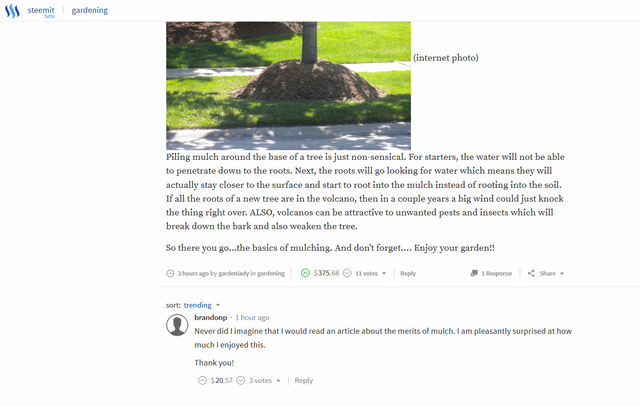
Tip 2. Praise the post, if it’s good. Steemit is a positive place. We may disagree (see below), but the vast majority of the comments that have been upvoted in the past are replies which tell the original poster that he or she wrote a good article. Some voters will not take the time to write their own comments, especially if they basically say the same thing (“nice post”). But if they see that you have written something like this already, there is a much greater chance they will simply upvote your comment.
Have a look at this screenshot, which shows a response by @nanzo-scoop to a post by @steemship. It is a positive comment, basically thanking and agreeing with the poster, but taking care to state the reasons why. Striking early with a positive, thoughtful reply like this can get some upvotes.
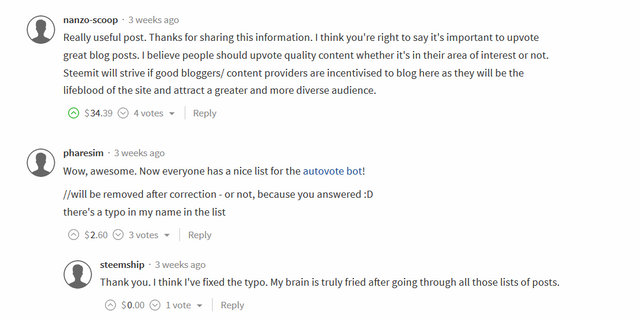
Tip 3. Highlight and Respond. In your reply comment, you should write more than simply “Nice post.” Use your comment to highlight something the author wrote or respond to the points that he/she made. Was there something in particular you liked about it? Did you agree or disagree with the points this author made? Why? Be honest and give your opinion, pro or con. You can disagree if you want, as long as you are respectful. Different perspectives are healthy.
This story of a bad travel experience with a crummy airline by @val elicited some good replies (see screenshot below). Tom, @donkeypong, thought he’d made a pretty good response, but @pfunk’s reply was a stronger one, responding directly and pointedly to an aspect of the article. Other readers/voters who stopped by agreed that @pfunk’s reply was right on point.
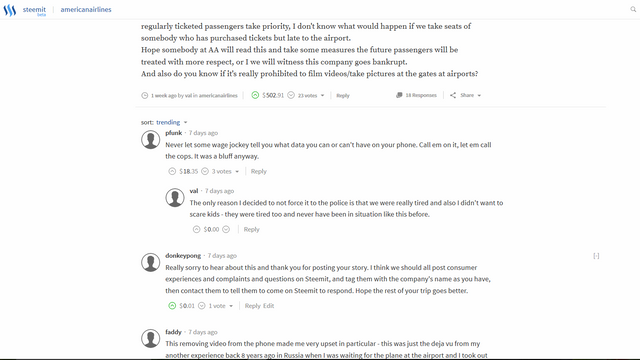
Tip 4. Add useful information, correct something, or ask a question. Did the author misstate something? Leave out part of the story? Do you know something more about this topic that was not covered in the post? Maybe it was a good post otherwise, and you can tell them so, but point out something else the original author did not include or did not state correctly. This works great in technical postings, by the way, which have resulted in the most prolific reply comment chains so far on Steemit. Alternatively, if you thought the author just did not understand the subject well and made a mess of it, you can be honest about this also. Again, be respectful.
Example: Your post was very thoughtful. However, I think readers would appreciate knowing that there is a formula for this, which is…”
If you look back at the screenshot for Tip 2, above, you will see another comment on that post in which @pharesim points out an error.
The screenshot below shows one more example of this tip in action. Look how @innuendo added something by posing a question to @steempower’s article.
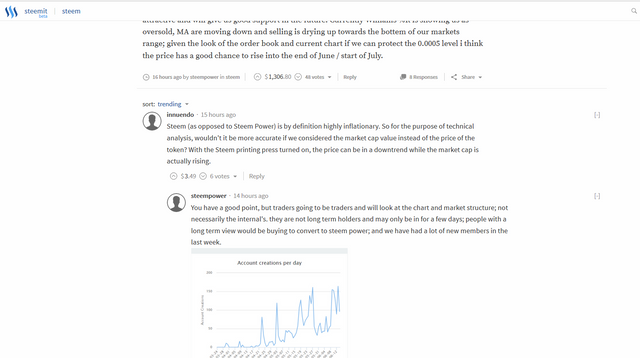
Tip 5. Aim for about one paragraph in length. Sometimes, one sentence is enough, but there’s a good chance someone will come along and add to the conversation more meaningfully than you have (and then their comment will get the upvotes). One sentence does not show much effort. On the other hand, if you write too much, most people won’t read it (TL;DR), unless you truly have something useful to add that requires extra space to explain. From what we have seen on highly upvoted reply comments so far on Steemit, 2-5 sentences is a good target length, though that should not limit you if you genuinely have more or less to write.
Chapter 8: Mining STEEM
There is another way to earn STEEM also: by mining it with a computer. When the STEEM cryptocurrency first launched, the first people to mine it accumulated more STEEM than one is able to get today. At that time, few people knew about it, but now there is more competition for discovering this scarce resource. Nevertheless, you can still earn some STEEM this way.
Mining is a distributed system of consensus that can confirm waiting transactions and include them in the blocks, which are linked to each other and collectively are known as the blockchain. When a block is produced, the miner whose computer discovers it can claim a reward in the form of some currency. The frequency and amount of rewards is pre-determined. So by dedicating computing resources to help the network conduct its record-keeping, you can earn STEEM.
A blockchain is a shared public ledger. Mining is the process of using your computer, or some external computing resources that you buy or rent, to help the cryptocurrency’s blockchain keep its records. The blockchain then uses your computing power to help include new transactions in the blockchain. Transactions are included in a block, which is a cryptographic record that fits very specific instructions.
How profitable is the task of mining STEEM versus the cost of energy and computing resources that you will invest in your mining operation? This a question you will have to research and answer on your own. We three co-authors of this book are not particularly technical ourselves (we’re the kinds who like to earn STEEM Power and Dollars by writing and upvoting!).
So instead of trying to write about the mining process ourselves, we defer to several sources which explain STEEM mining in much more detail. We especially recommend the “How to Mine STEEM in Windows” post below by @tuck-fheman, which has helped a lot of people learn how to dedicate their own PC power to mining. If, after consulting these sources, you still have questions about how to mine STEEM, please feel free to post your questions on Steemit with the #steemhelp tag or join Steemit’s Slack Channel at https://steem.slack.com. Both are frequented by developers and other programmers who are quite patient with newbie questions!
Resources on Mining STEEM:
- Original Steemit announcement on Bitcointalk
- Here are some mining instructions from Steemit.io
- Basic mining instructions: Ubuntu-15
- How to Mine STEEM in Windows
- Maximize your mining hashrate in Windows by mining Steem in a VM
Chapter 9: Steemit Economics 101
If you told people they could make money for posting on Facebook, Twitter, or Reddit, what would they say? “Sign me up”, right? It’s not just the money. It’s the fact that people already spend many hours of their lives posting, watching, reading, and responding to others’ posts on social media sites. This work enriches the sites’ owners by creating a more valuable site that can sell more advertising, but the user who posts or reviews content does not get paid for it by Facebook, Reddit, or other social media platforms.
Did we say ‘work’? It’s not work if it’s fun! And if you find posting and reviewing others’ posts to be fun, then Steemit is the perfect place for you. It’s time you got paid for all your hard work and fun. We have discussed the posting and upvoting opportunities, which reward you with payouts. Now it’s time to talk about the financial aspects of Steemit.
Before we do, please keep one thing in mind as you read this section: Steemit never handles real money. This is not a bank or a financial institution. It’s not a stock or a commodity. No financial product or service is being offered. When you Power Up, you are not “investing” in any financial sense. There are three “currencies” in Steemit (STEEM, STEEM Dollars, and STEEM Power), all of which are merely tokens inside this ecosystem. When you get paid for posting, voting, or commenting, the money is paid directly from the blockchain and not from Steemit, Inc.
Viewed this way, Steemit is a massive multi-player game. It just happens to be a game where you can earn rewards that are paid 50% in the form of price-stable tokens (STEEM Dollars) that are worth about $1 apiece. With a few clicks of a button, these can be converted outside Steemit to Bitcoin or other currencies. And you also get rewarded (the other 50% of your payout) with other tokens (STEEM Power) that grant you the promise of more rewards, the more you accumulate and hold, and the longer you hold them actively (though you can cash them out also over a two-year period if you prefer).
Where does Steemit’s money come from? First, its platform and business model are much leaner than any other social media site. Because Steemit uses the blockchain, which can verify and automate much of the work (such as payouts), there is no need for an expensive corporate structure. The money that’s saved can be paid to users.
Second, Steemit uses an inflationary cryptocurrency that has tremendous value inside this system (and soon, we hope it will have more value on other websites that accept it also). Essentially, this is the same way that the U.S. dollar has inherent value, except there are fewer uncertainties with Steemit. The rate of inflation with STEEM is programmed in; a certain amount of new STEEM is created each day, and that is what is paid out to blog posters and voters. People who vote with their STEEM Power stakes decide how the money that’s created will be allocated.
Steemit’s Market Value
Like any company, Steemit is valued at a certain price by the market. Facebook has a market capitalization of $325 billion, which the market arrives at by taking the price of Facebook’s stock and multiplying it by the number of outstanding shares. If someone wanted to buy all of Facebook’s shares, they probably would need to pay more than this, and that would establish a different fair market value.
Steemit’s liquid currency, STEEM, also has a market cap, which you can find by visiting the site www.coinmarketcap.com. This site displays the coin price and total market capitalization for Bitcoin, Litecoin, and all of the other cryptocurrencies. Taking the quantity of outstanding STEEM and multiplying it by the current market price of STEEM, the site is able to display a number for its market cap. The number might be $10 million or $50 million or more.
That’s a good start, but we know that Steemit is much more than a coin. In Steemit’s young history, there have been short periods where the user base has grown by hundreds and the website ranking has jumped considerably, yet during that same time period, STEEM’s market cap has declined by 1% or 2%. And that’s because the market cap does not look beyond the available currency, nor does it consider the stakes held by founders, even though they are releasing it into the market over time to help pay for development, marketing, and user rewards.
STEEM’s market cap is only a fraction of Steemit’s net worth. A better measure would consider all three of Steemit’s currencies, STEEM, STEEM Dollars, and STEEM Power, and including some of the founders’ shares as outstanding currency, though even that would probably underestimate the site’s value. If you would like to read more about the issue of valuing Steemit, please click here for an insightful post by Daniel Larimer on that issue.
Advertising provides the main source of revenue for social media sites like Facebook. And yet advertising revenue represents only a portion of that site’s actual value. The rest of its value is in its people. Remember, Facebook’s high valuation comes largely because it has access to one billion people. They also spend a certain period of time on the site and remain engaged with it, which leads to a higher valuation.
Ned’s Buckets
As Steemit grows and adds users, its value will grow, too. What Steemit’s founders did was to establish a market cap valuation for STEEM first and then use the new money that’s created from this inflationary currency to reward people who post and curate content on the site. If you read the mining chapter earlier, then you might recognize this idea. Yes, anyone doing the work of posting and voting is essentially mining STEEM Dollars and STEEM Power.
Steemit’s CEO, Ned Scott, has discussed this using the analogy of several buckets being filled. As new money is created to fill buckets, this money can be allocated to reward payouts. The money already in the buckets, which is needed to maintain Steemit’s market cap valuation, is not touched. So the best of two worlds exist at once:
1.) Steemit has a stable market cap and can pay people partly in a market stable currency token (STEEM Dollars).
2.) Yet Steemit has a constant source of income as new money is created. This money can be allocated to pay users who are “mining” the currency by doing the work (posting and curating) of creating a more valuable site. Yes, it anticipates and leverages future growth, but even in the event that growth does not come, the market cap provides a floor and payments can continue.
Steemit Has Unlocked the Untapped Value in Social Media
In conclusion, the big takeaway from this chapter is that Steemit has found a way to unlock the value of a social media platform. Why not let them get paid for doing the work of building a more valuable business? And so, rather than sell them advertising and mine their data so that advertising can be targeted to them, there’s a better way to tap into the site’s value. Steemit has managed to unlock value, leverage growth, and yet maintain the established market cap as a floor to protect reward payouts to its users.
The caveat here is that the value of money in Steemit is constantly being diluted. It’s inflationary. As new money is created, existing currency is worth less. But there is a place where a lot less dilution occurs, especially when you remain active on the site. Please read the next chapter to gain a fuller understanding of STEEM Power and how its proportionally increasing rewards are the icing on this cake.
Chapter 10: STEEM Power: Betting on Steemit’s Growth
We think the best Steemit article on Powering Up was written by Tom, a.k.a. @donkeypong. It is incorporated in this chapter. If you would like to read the full article, please click here.
Steemit is built for the long game. You should build your plan that way, too.
The great physicist Albert Einstein is often credited with quotes he probably never said. Whether it happened or not, there are a number of references to Einstein answering a reporter’s question at the Institute of Advanced Study at Princeton University in the 1950s. When that reporter asked him what the greatest invention of all time was, Einstein apparently thought for a moment and then replied, “compound interest.”
Compound interest is easier to understand than the Steemit financial system. But once you appreciate what makes compound interest great, it will help you realize the full power of Steemit Power Ups. Once you do, I hope you will agree with me that each of us, like Steemit, needs a long term growth plan of our own.
Treat Steemit as a long term investment now. It can be your ATM machine later.
I am not offering investment advice. Putting time and money into cryptocurrency always comes with risks, namely the potential loss of said time and money. But Steemit pays people in a relatively stable currency and it has a mechanism to fund growth, so it comes with fewer risks and greater opportunity than anything else in the crypto space. That opportunity is most rewarding when you take a long term view, not a short term one.
Sure, I fully understand that you probably need money, have bills to pay, or have things you want to buy. But if at all possible, WAIT a while to cash anything out from Steemit. If you wait to cash out for a few months, invest most of your blog and voting rewards into Power Ups, and continue to post and curate on the site during that time, then you may soon have a lot more money to spend on these things.
Instead of withdrawing all your earnings immediately (let’s say it’s $200), exercise some patience and you might be able to turn that “Power Up Principal” into an income of $200 every month or every week. Again, there are no guarantees of what will happen in the future, but if you believe this platform will continue to grow, then Steem Power may be a wise choice.
Compound Interest vs. Simple Interest
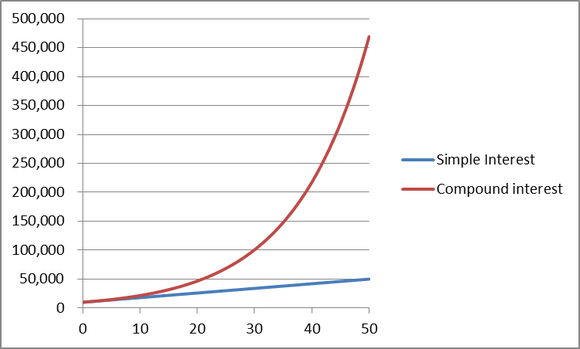
Compound interest is not a perfect analogy for Steemit, but it's a useful one, understanding that there are some differences.
Simple interest pays you a percentage based on how much money you have deposited. The money you have deposited is called your principal. And so the interest is calculated only on your principal. The appreciation of your money is called simple growth.
Compound interest gives you a percentage based on your principal AND on any interest you have accumulated from past periods. Over time, as you earn more interest, the pot of money grows. So does the amount of interest you are drawing, since it is being calculated on a bigger and bigger pot of money. This growth rate is exponential.
Here’s another chart which shows you a screenshot from a compound interest calculator. As you can see, the amounts can change based upon different inputs of information. You could begin with one investment and later add more money. You can fiddle with the period of time or the interest rate to make it more accurate. If you’re paying taxes, you can include that, too. I just want you to see that any of those can affect how much money you make over time.
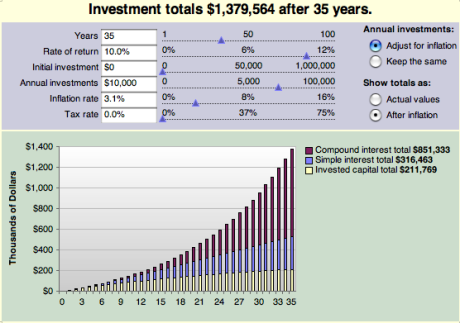
Some people see that chart and think, “$1.37 million looks pretty good.” Others see it and think “35 years is WAY too long!” Fortunately, with Steemit, the growth should happen a lot more quickly (for a number of reasons, which we will cover below).
The Power Up Principle: Leveraging Your Principal
Here’s another chart (below). Even though this shows a growing bank account balance, we can imagine (with a few caveats) that it could more or less apply to growth of earnings on Steemit.
The growth here looks sharper because it’s not based upon just one initial deposit. This shows what happens when you contribute a small amount (say, $25 in value) every week for a period of time. See how much more you can make? Again, we would want a much shorter time frame than this, which is quite likely, given Steemit’s additional features.
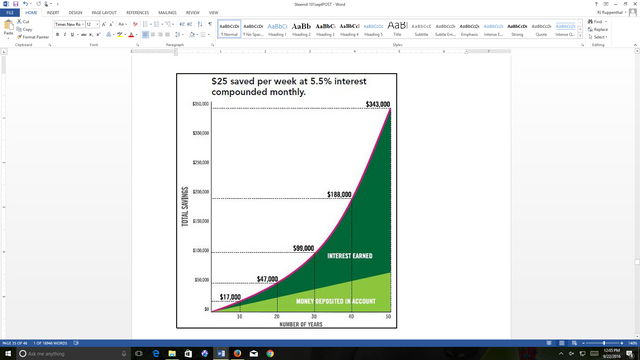
But there’s one more thing I want you to consider from the above chart. See how small the principal was at first? Imagine that the initial principle is the value you put into your Steemit Power Ups. If you had taken half of your earnings immediately as a payout, then you would have started with half as much. How much longer would this growth have taken? Alternatively, if you started with $100 or $1000 instead of $25, how much faster could that growth have accelerated?
Nine Times More with Power Ups? You’re Kidding!
I am not kidding. Steemit creates new money every day on a fixed schedule; that’s how this project pays for so many things. Unlike government central banks, Steemit is not borrowing that money from a mega-bank who had borrowed it from the government central bank in the first place through some shady program, creating more zeros we don’t really have plus more debt on computer screens.
Instead, Steemit is very honest about how it is paying for growth and development. Inflation is built in and there is a growing community of users who are adding more value to Steemit and its currency in every moment of every day. Reddit has almost 40 million users. Don’t you think that Steemit, a site that pays people to post and vote while Reddit doesn’t, is going to keep growing rapidly as it adds users for at least a few years? Theoretically, it can continue growing for a long time in many directions, as developers and merchants add new features and related applications that encourage people to spend more time on the site and continue adding to it.
Did I mention that Twitter has 300 million users? Facebook has one billion users around the world. People on all of these sites are complaining how corporate and how controlled the content has become. With Steemit, users provide the content, and the only content control comes through users voting on the posts. Facebook, Twitter, and Reddit need advertising to survive; Steemit doesn't. If we decide to allow ads, then that's a community decision, but the real advertising comes from the upvoting of posts. “I’d switch if they paid me.” Oh yeah, Steemit does that, too. Quite the incentive, isn’t it?
We’ve established that Steemit creates more money every day. Do you know where most of each day’s money is going? Sure, Steemit’s posters and voters are being paid well. But out of every 10 dollars created, nine of them (9!) go to those who have powered up.
Let me re-phrase and re-state that. In fact, let me draw your attention to this quote from the Steemit Whitepaper:
“Steem Power rewards: For each STEEM created by the above (posting and curation) rewards, 9 STEEM are divided among all Steem Power holders.”
Note: Here is another link to the whitepaper if you would like to read the full discussion.
In summary:
1 = How much of every 10 Steem created go to voting and curation rewards.
9 = How much of every 10 Steem created go to vesting Steem Power holders
That means that when you Power Up, you are putting yourself in line to gain big-time interest. Yes, it exists to offset the inflation rate, keeping your money protected. But as Steemit continues to grow proportionately, your Power Up value is essentially granting you a bigger and bigger stake in Steemit.
Powering Up is like trading in earnings for stock options on a stock you think will go upwards, through the roof and to the moon.
Minting Money. Like Having Your Own Money Tree
When you Power Up, your voting power grows, proportionately to how much Power Up vesting stake you have. Use it how you want. You can vote for newbies posts, the most popular posts of the day, or whatever you feel is the best content to reward. When you do vote, you will be using your growing voting power to print more and more money for anyone getting your votes.
You could even vote for your own posts. Imagine the day when there is a Steemit # tag for whale posts. As a whale, you’ll be able to pay yourself a salary if you want just be upvoting your own post. And if getting a whale like you to upvote a post is the only way to ensure it rises higher (kind of like advertising), can you imagine how much future posters will want your votes?
Power Up. Get Your Share
Do you see now why, if you believe in Steemit’s future, you should be “investing” in Power Ups?
Long Term Plan
Your long term plan with Steemit should take into account how much money you need to cash out from here in order to pay for your needs. If all goes well, this thing should take off very soon. You don’t want to get left behind; you want a stake in this, too. You should Power Up. But also remember that when you Power Up, that vesting stake is locked up for two years, and you can only get it out in 104 equal payments made each week during this time. So be sure you really can spare and can invest this money before you do so.
Also, this is not a “passive investment”, unless you want it to be one. At least it will grow much more rapidly and grow much bigger if you also invest your time and energy to posting good content and upvoting other peoples’ good content on Steemit. Be a time and energy investor, a worker, too, and you will continue to build your rewards much more quickly. While STEEM Power also gets diluted by the incoming new money supply, this dilution will be trivial if you are earning more money and more STEEM Power from posting and voting.
Steemit is built for the long game. You need a long term plan, too. I’m pretty sure if Albert Einstein were here and he didn’t completely dismiss these cryptocurrencies or bootstrapped social media sites, he’d probably tell you the same thing: Power Up, as much as you can afford to do, if you want to share in Steemit’s exponential growth opportunity.
Chapter 11: Finding Up-And-Comers and Rewarding Good Quality Posts
When you first get on Steemit, you’ll probably encounter a lot of confusion. You’ll be asking yourself what type of content works and what doesn’t on the site. You’ll want to consider your own unique skills and interests after you become comfortable making posts, commenting and voting. Some people are more passionate about creating posts while others are more into curating and reading content. The beauty of Steemit is that both of these activities result in economic and social rewards.
Let’s discuss how to find up-and-coming writers.
- In the settings at the top of the Steemit site, you can choose how to view the feed. You can choose hot, trending, new, etc. To find new posts, choose the new setting.
- Scan the titles for information that peaks your interest.
- When you click on a post, you’ll know pretty quickly if the writing is interesting, funny, insightful, useful or just plain click bait. Click bait and empty posts are not upvoted with very much frequency.
- When you find a post that seems like it would be really interesting in some way to a lot of people, click the upvote button. Not only are you earning money from exercising your voting power; you also are helping Steemit curate its content by identifying the best posts so that, if others agree with you, they will rise to the top.
- What makes a good post is entirely subjective. Sometimes good posts don’t make it to the hot page. This is just reality. Choose your selected posts wisely because you can’t select an unlimited amount of posts to upvote each day. You have a limited amount.
- Popular posts still are mysterious, even to people who study analytics. Steemit voters tend to like original content better than re-posted videos or articles from elsewhere. If you share something brutally honest, funny, informative, useful or solve a problem that a large number of people have, then that post most likely will be popular.
- But, contradicting # 6, what’s popular on other sites, may not be popular in Steemit. Since Steemit’s culture is different from mainstream corporate culture, good content does usually rise to the top in Steemit. People who post results of their personal research, their data, their love of something, their art, their honest opinions and feelings about a certain topic do well. It seems to be that the more original and unique the post is, the more it will be rewarded.
- Go with your gut when you upvote a post. If the post made you say to yourself, “Aha! Or Wow! I’d never thought of that!”, then there’s a good chance many other people will have the same reaction. You’ve just helped that piece of content get distributed to a wider audience and you’ve paid yourself in the process.
Chapter 12: Introduce Yourself Nicely
This chapter is based on another gem of an article by @cryptoctopus.
Steem is the first cryptocurrency that attempts to accurately and transparently reward an unbounded number of individuals who make subjective contributions to its community. This dynamic brought an interesting phenomena on Steemit.com since its inception. People started, slowly first...then at an accelerating pace to introduce themselves to the community via the hashtag # introduceyourself. So much so that in terms of rewards, it became the second most popular topic. We will outline the principles that make for a great introduction, why it's important and the # 1 mistake you need to avoid in order to make a good first impression.
“You never get a second chance to make a great first impression.”
― Olivia Fox Cabane
Why?
The highest currency you have on this platform is your reputation. Reputation is built upon a foundation and that foundation can start with a well written post to introduce yourself to the community.
Also, as human beings, we are wired to respond to storytelling. There is something magical that happens whenever we share our personal story with our peers. Bonding, respect and appreciation is built when we reveal our history in an eloquent and elegant manner. This may be why that tag has become so popular.
The Method
1. Transparency is Valued
Many people who are on the bleeding edge of technology are extremely protective of their identity and seek anonymity online. But it is difficult to build a relationship or trust with someone who is anonymous. Not impossible of course, but more difficult for sure.
Signs and signals of transparency include sharing your real name, having a picture of yourself in the post, the sharing of your story and letting people know about your goals and dreams for the future. Because there have been some questionable introductory postings, the Steemit community has moved quickly towards expecting #introduceyourself posts to include "Hello Steemit! 12/09/16" (the date of the picture and post). Those who go to this length to introduce themselves are likely to get more upvotes and more acceptance in the community.
Of course, pictures can be faked also. Another method of verification that works well is to confirm your identity using another social media site (or blog page, if you have one). For example, if you are on Twitter, you could tweet from your account that you are now on Steemit. On another site, you could post the link to your Steemit post. With some quick editing, you can even get that link into your Steemit post or add it by posting a comment to your main piece. The community appreciates these extra steps.
2. Showcase Yourself as an Asset to the Community
The value of Steemit is intimately link to the value that each member brings to the network. When people hear that you have skills, talents or connections that will enhance the value of Steemit, they will be excited by the fact that you've decided to join "the club".
It is a good time to ask yourself "What is it that I am here to give?" This type of question will put you in the right mindset to write your # introduceyourself post. The allure of money making can attract people who are here to get rather than to give. Fortunately, this mindset tends to jump out of the page.
If you are a film-maker showcase some of your work. If you are an entrepreneur, tell us about your excitement about sharing your knowledge and experience. You get the picture.
3. Showcase Your Attitude
When you meet someone for the first time, do you want them to think of you as an upper or a downer? Optimism, interest, excitement, gratitude and fun create a strong first impression. If the first thing you talk about is how bad and shitty your life is...then you are not off to a good start.
There’s a caveat here. If you've went through terrible events but you've somehow found power within yourself to emerge better and victorious...this type of story is what people get truly inspired from. Please share if you have that type of story.
4. Be Genuine and Truthful
People have an innate BS detector and Steemians are incredibly smart. If you lie, someone's antenna will perk up and they'll call you out. They will look into the dark corners of the internet and share their findings in the comment section below the post. That would be catastrophic for you and your reputation. Being honest is the only sustainable way to be successful on Steemit.
5. Make Your Post Stand Out
Choose a good thumbnail picture for your post, make the text in the preview portion stand out, and in general, make it irresistible to click on. Also, make sure you provide more value in your post than 99% of people. Click here for a great article by @cryptoctopus on making your post stand out.
Don't Be That Guy
You may have reservations, questions or be completely lost about how the platform works in the fine details. But an #introduceyourself post is not the place to put them.
Under no circumstance write something like this:
“I have to be honest, I am not excited about STEEM because...”
That's just starting on the wrong foot. It's like if someone showed up to your party and said to you that he think that your place stinks and that they are being honest by telling you so. It's simply is not the place to write that stuff. Keep your skepticism at bay UNLESS you've found a genuine issue and that you have a possible answer to solve it. Even then, it’s probably better to post questions and concerns in a tag like # steemhelp instead of the # introduceyourself category.
These are the core principles for you to get started on the platform in a way that puts your best foot forward.
Chapter 13: How to Deal with Trolls and Bullies
Leah, @stellabelle, wrote the following article, which we were glad to incorporate into the book.
On every social media platform, there will come a time when someone will disagree with you or your personal beliefs. You might even encounter someone who hates what you represent. This is unavoidable and might initially occur more so on a platform like Steemit because it encourages free, uncensored expression. Freedom is a wonderful thing to have, but freedom without principles often leads to vulnerable people being abused or exploited.
Steemit has a different and more robust way of handling trolls and abusers and is entirely unique in its approach and effectiveness. Instead of relying on centralized control measures and moderators, everything that happens in Steemit is tied to an economic reward system.
By tying an economic incentive to your identity in Steemit, and by having all interactions recorded in the blockchain, individuals who needlessly attack others are not economically rewarded for their behavior. It goes pretty much like this: if you attack people and you generally don’t add much value to the community, you won’t be getting much in the form of economic, influential or social rewards. Conversely, the more helpful and useful you become to Steemit, the more economic and social rewards you’ll receive. There really has never been anything like Steemit before on the internet. There are other dynamics at play, but for our purposes, let’s get back to the topic of trolls.
By using these guidelines, you will have a working toolbox that can help you feel more successful and safe. I stand by it because I have used these methods myself and they work. I’m extremely optimistic that freedom, economic success and diversity can exist on Steemit as well as in other online communities. There will be growing pains, though.
How to Recognize a Troll
• Trolls use confrontational language to attack people and ideas for the purpose of gaining attention.
• Trolls do not add constructive or useful information to a topic.
• Trolls use a variety of strategies to incite anger in someone. They usually ask innocent questions to begin with, but then quickly follow up with something designed to hurt or provoke.
• Trolls are generally suffering on some level or another and they seek to disrupt others for their personal gain or agenda.
• They feed on others and share similarities with parasites.
• Trolls are sometimes sent into online communities to create disinformation or to disrupt a social, political or other movement.
Actions to Take When Dealing with Trolls
Step 1:
Recognize the signs of a troll (as explained earlier in this chapter)
Step 2:
The expression, “Don’t Feed the Trolls” is a popular one because it generally works. When someone has singled you out and is writing negative comments to get you riled up, simply ignore them. They will eventually leave you alone because they will not be rewarded financially or socially for their abusive behavior.
Step 3:
Use your energy wisely. If you find yourself getting sucked into a heated debate with someone who is abusing you, maybe it’s time to stop and redirect your energy. You don’t have to do this, but the economic rewards are greater if you use your energy to share your value in whatever way you want on Steemit.
Step 4:
When disagreeing with someone, try to give them respect, but state your honest perspective. If you notice that a person is not dealing with your topic, but is instead personally attacking you, leave the conversation. If you don’t, your energy will most likely be wasted and your wallet will be emptier.
By following these guidelines, you will find yourself creating a reputation that continues to grow and reap rewards, both socially and economically. If you’re a troll, you probably won’t be benefitting too much from Steemit, unless you’re interested in learning about radical self-discovery and acceptance. But the very nature of Steemit is voluntary. You don’t have to follow these guidelines if you don’t want to. You are free to experiment and find your own path.
Chapter 14: Following Your Favorite Posters
Steemit gives you the opportunity to Follow your favorite posters. This makes is easy to find top-level posts from successful writers that are more likely to have a larger payout that you can share in, either by voting or commenting on those posts. It also means that you can follow any up-and-coming writers that seem to be posting good content that is starting to become popular.
But most importantly, you can use this feature to follow friends or anyone who writes blog posts you like to read. For example, if you are particularly interested in a topic like law, you might decide to follow Richard’s blog, since he often writes about that subject. For now, if you need to communicate directly with others on the platform, the best way to do this is to join Steemit.chat .
You can find the Follow button on any user’s main blog page. To get there, just click on the user’s name or type it into your address bar after the Steemit address like this:
https://steemit.com/@donkeypong
https://steemit.com/@cryptoctopus
https://steemit.com/@stellabelle
https://steemit.com/@steemship
Near the top right of the page, you will see Mute and Follow buttons (see screenshot below). You can Unfollow or Mute us if you don’t want to hear from us again, or Follow us if you want to read our posts! Please note that the first two posts in this screenshot show “Re-Steemed” posts from other users that @donkeypong sent out. To Re-Steem something, just look for the recycle arrow at the bottom of each post.
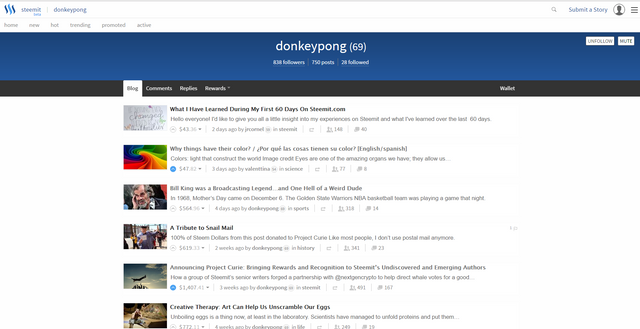
Chapter 15: A Supportive Community
Steemit offers many different attractions for different people. Even if you’re not the greedy sort, it offers a great chance to make money by doing things you like: posting, voting, and having fun. Why not get paid for the time and effort you spend on the site? It offers a social media platform that is controlled only by its users, the Steemit community. And it provides all of us with that community. Whether you need help getting started, have a question, or want to tell us your story, Steemit’s community is very supportive.
We hope you have enjoyed this brief overview of Steemit. As co-authors of this book, our duty to help you does not end on the last page. If you need anything from us, please contact us through the site or via Steemit.chat. The last section below provides some more information about each of us and how you can find our Steemit blogs.
Appendix: About the Authors and Contributors
Tom Janowicz, Editor and Co-Author, is also known as @donkeypong on Steemit. Tom is one of the highest earning writers on Steemit, though his dog Ziggy actually writes his best material. In his day job, he creates reports for a financial services firm that handles due diligence for mergers, acquisitions, and certain investments. He often feels like a cog in the corporate wheel, and he is excited about Steemit’s potential to put social media beyond corporate and government control. Tom regularly writes about Steemit’s importance and how to get the most out of its opportunity, plus he publishes a regular Blog Spotlight newsletter on Steemit to draw attention to good, up-and-coming writers. You can follow @donkeypong’s blog by clicking here and then choosing the “Follow” button on the top right.
Renaud Gagne, Co-Author, is also known as @cryptoctopus on Steemit. Renaud has made a meteoric rise on the Top 10 list of most popular authors. He is a marketing specialist who has sold over $3 million of ads on Facebook alone. Shortly after he joined the Steemit community, Steemit’s CEO wisely put Renaud in charge of the Steemit Facebook page. He writes regularly about psychology, marketing, and how make the most out of Steemit, influence and once in a while about his social/political outlook. His hobby include but are not limited to archery, powerlifting, travelling, playing trombone, juggling clubs, biblical study and theology. You can follow @cryptoctopus’ blog by clicking here and then choosing the “Follow” button on the top right.
Leah Stephens, Co-Author, is also known as @stellabelle on Steemit. Leah writes books and a Steemit blog under the pseudonym, Stellabelle. She is an independent writer, artist and YouTuber. In 2015, she self-published her first book on Amazon, Un-Crap Your Life: Navigating Life’s Crappiest Situations. She’s currently a technology writer with many clients. She accidentally discovered Steemit while doing research about a programmer who automated his own job. She stumbled into Steemit, became intrigued and just never left. She sees immense potential in Steemit and realizes that blockchain technology has the potential to fundamentally change the world. She believes that freedom, creativity and independent thought can move society forward if given a fair chance. You can follow @stellabelle’s blog by clicking here and then choosing the “Follow” button on the top right.
Richard Kaplan, Co-Author, is also known as @steemship on Steemit. Richard has written several of the highest-earning posts on Steemit. He sees Steemit as a way for average people to make a good income by writing, voting, and commenting on posts. A former lawyer, he blogs on Steemit about law and the Steemit opportunity. Richard believes everyone should use half of their votes each day to reward new users who post the best content on Steemit. Come find him if you want some votes! You can follow @steemship’s blog by clicking here and then choosing the “Follow” button on the top right.
Contributors: We wish to thank @the-alien @infovore and @shenanigator for helping with revisions to this book since its initial publication. We hope you will follow their Steemit blogs also!
© 2016 – All original content is copyrighted by the authors.
Yes, finally a great post with just the information i needed, finally!
This is great! Thanks for sharing. Lots of useful information even for someone who has been on the site for 2 months... I will probably re-read this several times!
re-steemed
Thanks a lot for making this knowledge freely available!
Very good. valuable article
I purchased and read the original on Kindle. Thought you all did a great job (especially since I have seen some ... shall we say sub-par Kindle books related to crypto-currencies in the past). Reblogged :) @nonlinearone
I have read Part 1. It is because of this book that I decide to join Steemit. This part contained so much new information that was not found in Part 1
Excellent save me the address to read with more attention, so read is very good what you have posted thank you very much
Still a Steemit novice, it's second nature for me, as I think it is for most, to recognize and value originality, and to date I've been mainly looking at and commenting on the posts of people who have upvoted my own original work.
Recently reading about the negative aspects of the power of the whales, this article is like a 'breath of fresh air' for me. Will print it out to read ~ The old fashioned way ~ Sitting barefoot on the grass, taking it all in. Can you hear me clapping? BRAVO.
Recently I've seen comments on the pros and cons of re-blogging, as well as suggestions that there be a way of differentiating our own blogs from those we reblog. Any thoughts/suggestions on this ~ Even at this early stage?
It's so new that we're all learning about it. I can't make any predictions yet! But I agree that it's a mess to have all the posts in one place; separating them into different feeds on someone's blog would be nice.